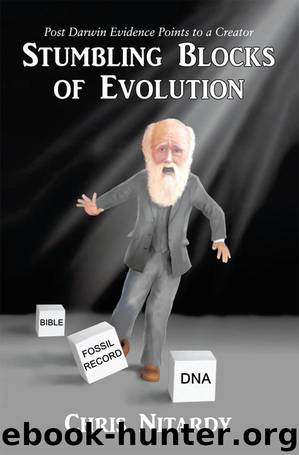STUMBLING BLOCKS OF EVOLUTION by CHRIS NITARDY

Author:CHRIS NITARDY [NITARDY, CHRIS]
Language: eng
Format: epub, mobi
Publisher: Xulon Press
Published: 2012-07-24T16:00:00+00:00
It’s difficult to believe that about 263 feet of ice accumulated over these planes in forty-eight years. This works out to about 5.5 feet of ice accumulation per year.31 This contradicts the presumption that each layer of polar ice is an annual layer. It’s become obvious that vast periods of time are not needed to accumulate many layers of ice in the arctic regions. As it turns out, each ice layer most likely represent a snowfall or a freeze/thaw cycle. In other words, there may be several, if not hundreds, of ice layers forming each year. Dr Carl Wieland with Creation Ministries International sums it up nicely:
Evolutionists and other long-agers often say that ‘the present is the key to the past’. In that case, the 3000-metre-long ice core [brought up by the joint European Greenland Ice-core Project (GRIP) in Greenland in 1990–1992] would only represent some 2,000 years of accumulation. Allowing of course for compression of lower layers, (which is also offset by the inevitable aftermath of a global Flood, namely much greater precipitation and snowfall for a few centuries32) there is ample time in the 4,000 or so years since Noah’s day for the existing amounts of ice to have built up—even under today’s generally non-catastrophic conditions.33
Coral Reefs: The Great Barrier Reef is the world’s largest coral reef system composed of over 2,900 individual reefs and 900 islands stretching for over 1,600 miles covering an area of approximately 133,000 sq miles. The reef is located off the coast of Australia and is large enough to be seen from outer space. The CRC Reef Research Centre estimates the age of the Great Barrier Reef at about 500,000 years old, but says it has not been present in its current form for all of that time. It estimates the present, living reef structure at 6–8,000 years old.
Drs. John Whitcomb and Henry Morris cited a study that found 20 centimeters of coral reef growth in five years. They wrote, “This rate of growth could certainly account for most of the coral reef depths around the world even during the few thousand years since the Deluge.”34
Dr Walt Brown agrees. He said:
Estimated old ages for the Earth are frequently based on “clocks” that today are ticking at extremely slow rates. For example, coral growth rates were thought to have always been very slow, implying that some coral reefs must be hundreds of thousands of years old. More accurate measurements of these rates under favorable growth conditions now show that no known coral formation need be older than 3,400 years.35
DNA: According to many sources, two microbiologists, Raul J. Cano and Monica K. Borucki, have brought ancient bacteria back to life! It’s widely reported that over 1,000 types of ancient bacteria and other microorganisms have been recently resuscitated; they say some of these life-forms date as far back as 135 million years. Wow. . .I would say that’s a long nap! Many scientists point out that Cano and Borucki took every effort possible to rule out contamination.
Download
STUMBLING BLOCKS OF EVOLUTION by CHRIS NITARDY.mobi
This site does not store any files on its server. We only index and link to content provided by other sites. Please contact the content providers to delete copyright contents if any and email us, we'll remove relevant links or contents immediately.
Sapiens: A Brief History of Humankind by Yuval Noah Harari(14142)
The Tidewater Tales by John Barth(12561)
Mastermind: How to Think Like Sherlock Holmes by Maria Konnikova(7138)
Do No Harm Stories of Life, Death and Brain Surgery by Henry Marsh(6829)
The Thirst by Nesbo Jo(6744)
Why We Sleep: Unlocking the Power of Sleep and Dreams by Matthew Walker(6537)
Life 3.0: Being Human in the Age of Artificial Intelligence by Tegmark Max(5391)
Sapiens by Yuval Noah Harari(5251)
The Longevity Diet by Valter Longo(4983)
The Body: A Guide for Occupants by Bill Bryson(4860)
The Rules Do Not Apply by Ariel Levy(4773)
The Immortal Life of Henrietta Lacks by Rebecca Skloot(4437)
Animal Frequency by Melissa Alvarez(4357)
Why We Sleep by Matthew Walker(4303)
The Hacking of the American Mind by Robert H. Lustig(4253)
Yoga Anatomy by Kaminoff Leslie(4233)
All Creatures Great and Small by James Herriot(4178)
Double Down (Diary of a Wimpy Kid Book 11) by Jeff Kinney(4118)
Barron's AP Biology by Goldberg M.S. Deborah T(4053)
